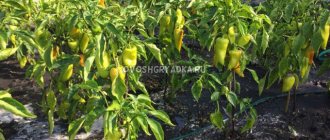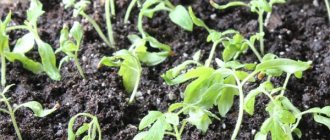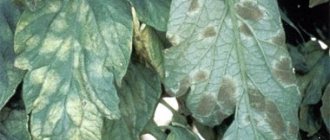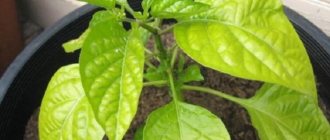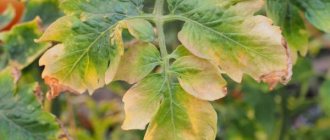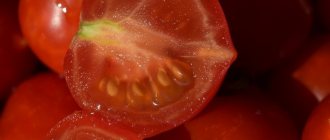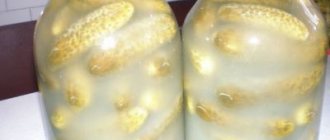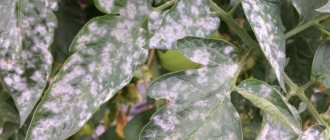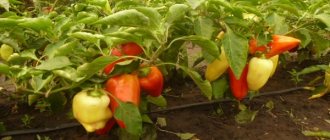Vegetable growing » Tomatoes
0
5148
Article rating
Kira Stoletova
Growing seedlings is a very important stage. Healthy, strong seedlings are well accepted in a permanent location. Plants grow that are capable of producing a good harvest of tomatoes. Sometimes during the growing process something goes wrong and the leaves of tomato seedlings wither. In such a situation, it is important to find the cause and do everything necessary to prevent it from dying.
Leaves of tomato seedlings wither: causes and solutions to the problem
Possible reasons
The main cause of all problems with the growth and development of seedlings is a violation of the rules of agricultural technology. Healthy seedlings can only be obtained by providing them with optimal conditions and following the rules of care. Any discrepancy leads to tomato seedlings withering, drying out or falling.
Poor quality soil
Tomatoes are very demanding on the composition and characteristics of the soil, and any discrepancy negatively affects their condition. The roots of this culture are not able to develop normally in dense substrates with high acidity. Some confidence that the soil meets all the requirements of tomatoes is given by purchasing ready-made mixtures.
But even in this case there is no 100% guarantee. The market for goods for summer residents is full of fakes, so it is better to purchase soil from trusted manufacturers from reputable sellers.
At the first signs of wilting of plants, it is worth checking the acidity of the soil and assessing its looseness. If the surface is dense and a whitish coating is visible on it, replanting is necessary with a complete replacement of the substrate with a new, looser one, with a pH value no higher than 6 units.
Improper watering
Regular moistening of the soil is one of the main measures for caring for tomato seedlings.
Many inexperienced gardeners mistakenly believe that this crop needs a lot of water, so they water the seedlings almost daily. This approach invariably leads to rotting of the roots.
Lack of moisture is also harmful to tomatoes. Plants may “hang” their leaves if the soil is dry and crumbly. It happens that the room temperature is high, and the vegetable grower waters the seedlings as recommended in the care manual. Therefore, tomatoes suffer from lack of moisture and begin to wither.
Dried tomato roots should not be poured with plenty of water. The soil is moistened gradually: throughout the day, a new portion is added, one spoon per root per hour.
Air temperature is too high or low
Tomatoes do not do well in rooms with inappropriate air temperatures.
Optimal indicators for normal growth of seedlings are + 20 – 25 degrees. When seedling boxes are placed on windows facing south, the sun can heat the air to + 30 and even higher. In such conditions, plants begin to wither and dry out.
The opposite situation occurs if the seedling containers are close to cold glass. Temperatures below + 15 degrees stop the growth of tomatoes and reduce their immunity.
Expert opinion
Chernyaeva Tatyana Dmitrievna
Absolutely loves gardening and grows only organic vegetables
Ask a Question
Particular care should be taken to ventilate the room in which the tomato seedlings are located. Streams of icy air from the window are dangerous for unhardened sprouts, even if they stand at a considerable distance from the window. Frozen tomatoes immediately begin to curl up their leaves and wither.
Diseases
The causative agents of fungal and bacterial diseases persist in the soil and seed and begin to develop when favorable conditions occur. The active growth of pathogenic microorganisms is promoted by high humidity in combination with elevated temperature.
The following diseases most often affect tomato seedlings:
Blackleg
Fusarium
Black rot
- Blackleg - a fungus that attacks the roots of tomatoes when there is systematic waterlogging or stagnation of water due to poor drainage. It is impossible to save plants affected by blackleg, so the seedlings will have to be thrown away.
- Fusarium - infection with this fungal disease is indicated by yellowing of the leaves and dark brown coloring of the vessels at the bottom of the stem. A sign of the disease is blackening of the stem at the bottom.
- Black rot is the cause of the development of this disease - a combination of excess humidity and low temperature. Rotten plants wither and then fall. Seedlings affected by the disease will not be able to recover, so they are removed by the roots.
Thickened crops
Maintaining the distance between plants when sowing is an important condition for proper growth and development of the root system. Thickening of crops leads to nutritional deficiency. The roots of the tomatoes are intertwined and interfere with each other. Therefore, after the formation of 2–3 true leaves on the seedlings, it is necessary to pick. It is better to plant the tomatoes in separate cups.
Low light level
Gardeners sow most varieties of tomatoes in the winter months, when daylight hours are still very short. As a result, the plants do not receive enough sun and therefore develop poorly.
Excessive sun exposure
Inexperienced gardeners mistakenly believe that the best place for seedlings is south-facing windows. But too much light is just as harmful to plants as too little. Hot and too bright rays lead to leaf burns. If the apartment windows face only south, the seedlings are placed some distance from them.
Illiterate feeding
Feeding tomato seedlings is important, but both a lack and an excess of nutrients are equally harmful to plants. Overfeeding with nitrogen has a particularly negative effect on the condition of seedlings. The sprouts begin to stretch and fall. In this case, the leaves turn yellow due to burns of the roots.
A lack of nutrition in plants can occur due to low indoor air temperatures. The absorption of phosphorus stops at temperatures below +15 degrees, nitrogen – at + 10.
Excess nitrogen in the soil
The plant must be fed regularly. This is done with the help of various fertilizers and microelements. However, excessive amounts of nitrogen can cause rapid growth of green mass and wilting of the tops of tomatoes.
Excessive watering helps solve this problem, however, due to excess moisture, the plant can become infected with fungus. To prevent this problem, fertilizers must be applied strictly according to the instructions.
Spraying with calcium sulfate (one teaspoon per liter of water) will also help balance out excessive amounts of nitrogen. The use of ash also gives good results (one glass per bucket of water).
After the pick
The unsightly appearance of sprouts after transplanting into separate cups or a larger seedling container is a completely normal phenomenon and you should not be alarmed. The roots need 2–3 days to adapt to new conditions. Seedlings experience stress after being removed from the soil, so they have to recover to continue development. If the transplantation procedure is performed correctly, the leaf turgor is restored and the tomatoes begin to grow actively.
In order not to harm young shoots, picking is carried out adhering to the following rules:
- The seedlings are transplanted after they develop 2-3 true leaves.
- To stimulate the development of the root system, the central part is lightly pinched by 1/3.
- Before and after picking, the seedlings are not watered for 2 days.
- Plant the sprouts in a pre-moistened substrate.
Tomato seedlings can wither if picking is done too early (before the seedlings are 10 days old) or too late (more than 20 days old), when the roots are already intertwined with each other.
Lack of fertilizers
A lack of beneficial microelements can lead to wilting of the top of the plant. It does not receive the substances necessary for its development.
Fertilizers must be applied in the days following planting. Before and during flowering, the plant needs increased nutrition to form fruits.
Read here - How to spray tomatoes: tips on choosing formulations for growth and repelling pests (105 photos)
How to help plants
At the initial stages of the development of problems, plants can be given “first aid”.
Timely measures will allow the seedlings to recover and continue development.
How to adjust watering
The soil in seedling containers should be constantly moist, but not wet. Watering is carried out regularly, but with a moderate amount of water. A large number of drainage holes helps prevent waterlogging. If tomatoes grow in plastic containers, they are additionally placed on the walls.
Expert opinion
Chernyaeva Tatyana Dmitrievna
Absolutely loves gardening and grows only organic vegetables
Ask a Question
A new portion of water is added to the soil after the top layer has dried by 2–3 cm.
How to balance fertilizing
You can determine which nutrients the seedlings lack by the color of the above-ground parts:
- If the lower, oldest leaves turn yellow, the plants do not have enough magnesium. For feeding 1 liter. add 1.5 - 2 g of magnesium sulfate to water.
- If the seedlings begin to stretch out and turn yellow, it means that it is necessary to limit the supply of nitrogen to the roots. Replacing the top layer will help reduce its concentration in the soil. Half the contents of the seedling containers are removed and fresh soil mixed with a small amount of sawdust is added. Alternatively, you can transplant the plants into new soil and after 10 days spray them with Epin.
- If the leaves are small and yellowish, the plants are lacking nitrogen. The addition of any organic fertilizer helps balance the diet.
- If the leaves have acquired a reddish or bluish tint, it means that the seedlings do not have enough phosphorus. In this case, the seedlings are fed with potassium monophosphate - 2 g per 1 liter. water.
- If the leaves turn white but the veins remain green, the plants lack iron. The seedlings need to be watered with iron sulfate (1% concentration solution).
Treatment of diseases
If seedlings are infected with a fungus, immediate transplantation into fresh soil and treatment with disinfectants is required. Watering with a pale pink solution of potassium permanganate or hydrogen peroxide (2 tsp per 1 liter of water) is effective.
You can also destroy the developing fungus with special preparations:
Hom
Profit Gold
Bravo
Fitosporin
More details
Preventive spraying of foliage with Trichodermin helps prevent infection of seedlings by fungal diseases - 2 times with an interval of 14 days.
Feeding tomato seedlings
The next reason that the seedlings began to turn yellow is the lack of nutrients in the soil. To do this, the plant must be fed properly.
We should not forget that an overabundance of fertilizers can cause not only burns to the roots of tomatoes, which will inevitably lead to the death of seedlings, but can spoil the top layer of soil, turning it into a hard whitish crust that blocks the access of oxygen to the roots of plants.
This crust needs to be removed and the tomato seedlings watered with a weak solution of humate for several days. It will help restore the soil and stimulate further seedling growth.
Methods to prevent the problem
Have your seedlings ever wilted?
RarelyConstantly
To grow strong, healthy tomato seedlings ready for transplanting into open ground, you must strictly follow the following recommendations:
- Seeds require pre-treatment before sowing . First, they are disinfected in a solution of potassium permanganate heated to 40 degrees. Then they are placed in an immunostimulating drug for 3 hours. Immunocytophyte has proven itself well. To treat 5 g of seeds, 1 tablet is diluted in 15 ml of water.
- Conduct sowing in special or well-made disinfected soil . The ideal composition of the soil mixture is turf soil (1 kg), humus (1 kg), leaf soil (1 kg), peat (2 kg), sand (0.5 kg). To increase nutritional value, add 1 tbsp to this volume of soil. l. superphosphate, urea and potash fertilizers. Before mixing, the turf and leaf soil are calcined in the oven for 30 minutes or heated in a water bath. Additionally, the prepared mixture is poured with a warm solution of potassium permanganate.
- Balance watering of seedlings . Use only water that has been standing for at least 24 hours at a temperature of 20–25 degrees. Regularly monitor the outflow of excess moisture through the drainage holes. If the water stagnates after watering, it means that all the holes in the container are clogged. They need to be cleaned.
- Provide plants with 12 hours of daylight . The ideal place for seedlings is south-east or south-west windows. If there are no such plants in the apartment, the plants will not receive enough sun and will develop too slowly. Installing fluorescent or phytolamps above the seedlings will help solve the problem. At night, the lamps must be turned off: darkness is also necessary for plants to effectively absorb nutrients.
- Create a favorable microclimate in the room . The correct conditions for growing tomatoes are air temperature + 20 - 25 degrees, humidity level 50 - 60%. An equally important condition is regular ventilation. But currents of cold air should not hit the seedlings, so the seedlings are taken out before the procedure. Ventilation of the room is carried out at least once every 3-4 days.
Compliance with all the rules and recommendations for growing tomato seedlings will help prevent the development of problems. Timely assistance at the first signs of wilting will give seedlings a chance to survive and continue active growth, and in the future guarantee a bountiful harvest.
Seedlings on the windowsill of an apartment
In general, a windowsill is not an ideal place to grow tomato seedlings. Even from a closed window, it blows into the cracks, the plants become overcooled, the leaves turn yellow due to the draft, so the tomato seedlings on the window wither, they may even die due to non-compliance with the temperature regime.
Before growing tomato seedlings on the windowsill, you need to seal all the cracks or cover the windows with paper. You cannot open the window - the plants will be destroyed by the cold wind.
It is not recommended to grow seedlings on window sills facing north, as they will wither and turn yellow from lack of light and excess cold air. In the best case, the seedlings will stop growing, in the worst case, they will weaken and fall, so it is better to move them from the windowsill to the table away from drafts, using artificial supplementary lighting.
You should not leave seedlings on windowsills facing south; direct rays of the sun harm the delicate stems and leaves of plants, they burn them, seedlings die from overheating, which is the main reason why tomato seedlings wither on a windowsill - they burn in the sun.
Insufficient watering
Tomato seedlings also die due to insufficient irrigation regime. The lack of moisture in the soil is characterized by its friability and increased dryness. But you shouldn’t immediately pour too much moisture into the tomatoes. In this case, it is better to start with watering 30 - 40 grams per plant. Otherwise, the tomatoes will turn yellow. In addition, the soil in the container should be loosened. This process is also called “dry irrigation”.
Dense seeding
During sowing, you need to place the seeds at a sufficient distance from each other. This is a very important condition, which in the future can affect the development and growth of tomato bushes. Too thick seeding leads to a lack of nutrients.
After two or three full leaves appear on the shoots, the plants need to be planted in separate cups. If sowing is too dense, the seedlings will be weak. After transplantation, such shoots are poorly received, look lethargic, and their tops and leaves droop.
It is difficult to replant; the roots of neighboring plants are intertwined so that they cannot be untangled without damaging them. This is the answer to the question why tomatoes wither and die after picking. .
